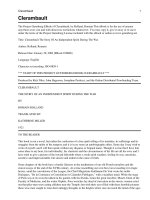- Trang chủ >>
- Mầm non >>
- Mẫu giáo bé
Segregation of Manganese Atoms during the Growth of Ge1-xMnxNanocolumns on Ge (001)
Bạn đang xem bản rút gọn của tài liệu. Xem và tải ngay bản đầy đủ của tài liệu tại đây (2.28 MB, 8 trang )
<span class='text_page_counter'>(1)</span><div class='page_container' data-page=1>
10
Segregation of Manganese Atoms during the Growth
of Ge
1-xMn
xNanocolumns on Ge (001)
Le Thi Giang, Nguyen Manh An*
<i>Hong Duc University, 565 Quang Trung, Thanh Hoa, Vietnam </i>
Received 20 May 2014
Revised 19 June 2014; Accepted 27 June 2014
<b>Abstract: High resolution - transmission electron microscopy (HR-TEM), along with Reflection </b>
High-Energy Electron Diffraction (RHEED) and Laser pulse atom probe tomography (LP- APT)
were used to investigate the growth kinetics of Ge1-xMnx nanocolumn on Ge(001) and the
mechanism of Ge1-xMnx nanocolumn formation. The results evidence that during the deposition of
Ge1-xMnx film, Mn atoms diffuse into the Ge matrix to form Mn-rich regions and the upward
segregation of Mn atoms along the [001] direction is the origin of the Mn concentration
enrichment inside the nanocolumns.
<i>Keywords: Diluted magnetic semiconductors, nanocolumns, Ge</i>3Mn5 clusters, Mn segregation.
<b>1. Introduction</b>∗
In the past few years, the synthesis of ferromagnetic semiconductors has become a major challenge
for spintronics. Actually, growing a magnetic and semiconducting material could lead to promising
advances such as spin injection into nonmagnetic semiconductors, or electrical manipulation of
carrier-induced magnetism in magnetic semiconductors [1,2]. Up to now, major efforts have focused
on diluted magnetic semiconductors (DMS) in which the host semiconducting matrix is randomly
substituted by transition metal (TM) ions such as Mn, Cr, Ni, Fe, or Co [3]. However, Curie
temperatures (TC) of DMS remain rather low and TM concentrations must be drastically raised in
order to increase TC up to room temperature. This process usually combines with the phase separation
and the formation of secondary phases. The origin of this phenonmenon probably arises from a very
low solubility of TM atoms in the semiconducting matrix.
The increasing interest in group-IV magnetic semiconductors can also be connected to their
potential compatibility with the existing silicon technology. Ge1-xMnx DMS would be a potential
candidate, since it can easily be integrated into semiconductor hetero-structures. Moreover, the spin
injection from Ge1-xMnx DMS is expected to be highly efficient thank to the natural impedance match
_______
∗<sub>Corresponding author. Tel: 84-903296502. </sub>
</div>
<span class='text_page_counter'>(2)</span><div class='page_container' data-page=2>
being fascinated by this finding, the kinetic formation of this nanocolumn phase is still interesting to
exame.
In this work, we report the mechanism of the formation of Ge1-xMnx nanocolumn phase. The
model concern to the lateral segregation of Mn atoms in Ge matrix due to the low solubility of Mn
atoms in Ge matrix and the vertical segregation of Mn atoms due to the sub-surfactant effect of Mn
atoms during the deposition of Ge1-xMnx film on Ge(001) substrate [16, 17].
<b>2. Experimental </b>
Ge1-xMnx films were grown by molecular beam epitaxy (MBE) on epi-ready n-type Ge(001)
wafers with a nominal resistivity of 10 Ω.cm at CINaM (Centre Interdisciplinaire de Nanosciences de
Marseille, France). The base pressure in the MBE system is better than 5 x 10-10<sub> Torr. The growth </sub>
chamber is equipped with a reflexion high-energy electron diffraction (RHEED) technique to control
the cleanness of the substrate surface prior to growth and to monitor the epitaxial growth process. Ge
1-xMnx films were obtained by co-deposition of Ge and Mn from standard Knudsen effusion cells. The
Ge deposition rate was determined from RHEED intensity oscillations whereas the Mn deposition rate
was deduced from Rutherford backscattering spectrometry (RBS) measurements. The standard growth
rate used in this work is of 1 – 2 nm/min.
The cleaning of Ge(001) surfaces was carried out in two steps: a chemical cleaning to remove
hydrocarbon related contaminants followed by an in-situ thermal cleaning at ~750°C to remove Ge
surface oxide layers. After this step, the Ge(001) surface generally exhibits a (2 1) reconstruction. To
insure a good starting Ge surface prior to Ge1-xMnx growth, a ~ 30-50 nm thick Ge buffer layer was
systematically grown at a substrate temperature of 400°C. Fig. 1a and b respectively display RHEED
patterns taken along the [1 0] and [100] azimuth of the clean Ge surface prior to Ge1-xMnx growth.
</div>
<span class='text_page_counter'>(3)</span><div class='page_container' data-page=3>
Figure 1. RHEED patterns taken along the [1 0] and [100] azimuth of the clean Ge surface.
Structural analyses of the grown films were performed through extensive high resolution
transmission electron microscopy (TEM) by using a JEOL 3010 microscope operating at 300 kV with
a spatial resolution of 1.7 Å. Particularly, the Laser Pulse Atom Probe Tomography (LP-APT)
technique was set up to determine at atomic scale the gradient of Mn composition inside
nanocolumns. LP-APT measurements were performed using an Imago LEAP 3000X HR microscope
in the pulsed laser mode. The analyses were carried out at 20.3 K, with a laser pulse frequency of 100
kH.
<b>3. Results and discussion </b>
As we have shown in the previous studies, under specific conditions of growth temperature and
Mn concentration, epitaxial growth of GeMn alloys on Ge(001) substrates can be resulted in the
formation of nanocolumns, which are orientated along the growth direction and entirely coherent with
the surrounding diluted matrix. We have provided, for the first time, that the Mn concentration in
nanocolumns is highly inhomogeneous, not only along the growth direction but also parallel to it due
to the core-shell structure [18-21]. To understand the variation of the Mn concentration in Ge1-xMnx
nanocolumns, we attempt, in this paper, to provide a phenomenological explanation of the Ge1-xMnx
nanocolumn formation.
The Mn concentration inside nanocolumns can be demonstrated by LP-APT measurements. That is
a three-dimensional useful technique in analysis of subsurface or buried features in specimens with
very high sensitivity. The high spatial resolution of the technique makes it especially practical in the
investigation the size, the composition, the morphology, and the evolution of the solute segregation
[22]. Indeed, the evidences of the Mn concentration gradient in the nanocolumns by an extension of
the iso-concentration series in 3D reconstruction is presented in Figure 2 for the Mn concentration
(CM) of 5, 15 to 25 %. It can be seen from this figure that the nanocolumn reconstructions near the
</div>
<span class='text_page_counter'>(4)</span><div class='page_container' data-page=4>
Figure 2. Iso-concentration surfaces made of the same volume for three different Mn
concentrations 5, 15 and 25 %.
To understand the mechanism of the nanocolumn formation, we first recall that under
non-equilibrium growth carried out at a temperature as low as 130 °C the Ge lattice can dilute a Mn
concentration of about 0.25 to 0.5 %. When the first monolayers of GeMn alloys with Mn
concentration as high as 4-7% (condition for nanocolumn formation) are deposited on a Ge surface,
excess Mn should diffuse and/or segregate along the surface to form Mn-rich regions. Differently
speaking, Mn-rich regions start to nucleate on the surface even after deposition of the first monolayers
and this is a direct consequence of the low solubility of Mn in the Ge lattice.
</div>
<span class='text_page_counter'>(5)</span><div class='page_container' data-page=5>
nuclei on the Ge surface. When the GeMn deposition proceeds, these nuclei may serve as seeds for the
nanocolumn formation.
Figure 3. RHEED patterns taken along the [1 0] azimuth of a clean Ge surface prior to growth (a),
during the growth of the first monolayers (b). Schema illustrating the nucleation of Mn-rich regions on a
Ge(001) surface due to a low solubility of Mn in Ge (c).
</div>
<span class='text_page_counter'>(6)</span><div class='page_container' data-page=6>
Figure 4. Schema illustrating the growth of nanocolumns from Mn-rich nuclei formed on the surface. Mn atoms
are shown to float upward to the top of nanocolumns. The cylindrical shape of nanocolumns allows them to
minimize their interface energy with the surrounding matrix.
Since the atomic radius of Mn atoms are slightly larger than that of Ge (127 and 122 picometers
for Mn and Ge atoms, respectively), if the Mn concentration inside nanocolumns is too high,
nanocolumns may exert a tensile train to the surrounding lattice. To reduce such a strain, a core-shell
structure with a reduced Mn concentration from core to shell should allow nanocolumns to more easily
adapt the lattice parameter of the surrounding lattice. Thanks to this self-organized core-shell
structure, almost all nanocolumns are found to be perfectly coherent with the surrounding lattice, as
can be seen in Fig. 1c and 1d of ref. 20.
To study the effect of the substrate orientation and in particular to verify the assumption of the
‘surfactant’ effect of Mn atoms along [001] direction of Ge, we have performed Ge<i>1-x</i>Mn<i>x</i> growth on
Ge(111) substrates. For GeMn-based materials, up to now Ge(111) substrates are mainly used for
epitaxial growth of the Mn5Ge3 compound, which has a hexagonal symmetry similar to a three-fold
symmetry of Ge(111) [23, 24]. Fig. 5a shows a typical TEM image of 80-nm-thick GeMn film grown
on a Ge(111) substrate. We note that the growth temperature is 1300<sub>C and the Mn concentration is </sub>
about 6%, i.e., at the same growth conditions for Ge<i>1-x</i>Mn<i>x</i> nanocolumns on Ge(001). The image
</div>
<span class='text_page_counter'>(7)</span><div class='page_container' data-page=7>
Figure 5. Typical TEM images of the 80-nm-thick Ge0.94Mn0.06 film grown on Ge(111) at 130 °C (a)
and a detailed view of Mn-rich streaks observed inside the layer (b). The Mn-rich streaks
form an angle α ~20 o<sub> to the growth direction. </sub>
<b>4. Conclusion </b>
The nanocolumn formation of Ge1-xMnx one have been described using a phenomenological model
based on a three dimension Mn segregation (i. e. the segregation both in-plane and along the growth
direction). The in-plane or lateral Mn segregation is driven by a low solubility of Mn in Ge while the
driving force of Mn vertical segregation is induced by the surfactant effect along the [001] direction.
Experiments of GeMn growth on Ge(111) surfaces seems to support the surfactant effect of Mn, which
floats upward the growth front along the [001] direction.
<b>Acknowledgments </b>
This work was supported by the National Foundation for Science and Technology Development
<b>(NAFOSTED) under grant number of 103.02-2013.66. The authors would like to thank Prof. Vinh LE </b>
THANH and Dr. Minh Tuan DAU - Centre Interdisciplinaire de Nanoscience de Marseille
(CINaM-CNRS), France for their help.
<b>References </b>
[1] H. Ohno, D. Chiba, F. Matsukura, T. Omiya, E. Abe, T. Dietl, Y. Ohno, and K. Ohtani, Nature (London) 408
(2000), 944.
[2] H. Boukari, P. Kossacki, M. Bertolini, D. Ferrand, J. Cibert, S. Tatarenko, A. Wasiela, J. A. Gaj, and T. Dietl,
Phys. Rev. Lett. 88 (2002), 207204.
[3] T. Dietl, Semicond. Sci. Technol. 17 (2002), 377.
[4] Y. D. Park, A. T. Hanbicki, S. C. Erwin, C. S. Hellberg, J. M. Sullivan, J. E. Mattson, T. F. Ambrose, A. Wilson,
G. Spanos, and B. T. Jonker,Science 295 (2002), 651.
</div>
<span class='text_page_counter'>(8)</span><div class='page_container' data-page=8>
88 (2006), 112506.
[13] T.B. Massalki, Binary alloy phase diagrams, 2nd<sub> Edition, Vol 1, 2, ASM International 1992. </sub>
[14] Thesis of T. Devillers, Etude des propriétés physiques des phases de Ge1−xMnx ferromagnétiques pour
l'électronique de spin, 2009.
[15] T. Devillers, M. Jamet, A. Barski, V. Poydenot, P. Bayle-Guillemaud, E. Bellet-Amalric, S. Cherifi, J. Cibert,
Phys. Rev. B 76 (2007), 205306.
[16] Wenguang Zhu, H. H.Weitering, E.G.Wang, Efthimios Kaxiras, and Zhenyu Zhang, Phys. Rev. Lett 93 (2004),
126102.
[17] Changgan Zeng, Zhenyu Zhang, Klaus van Benthem, Matthew F. Chisholm, and Hanno H. Weitering, Phys.
Rev. Lett 100 (2004), 066101.
[18] T-G. Le , M-T. Dau, V. Le thanh, D. N. H. Nam, M. Petit, L.A. Michez, N.V. Khiem and M.A. Nguyen, Adv.
Nat. Sci.: Nanosci. Nanotechnol. 3 (2012) 025007.
[19] T-G. Le, D.N.H Nam, M-T. Dau, T.K.P Luong, N.V. Khiem, V. Le Thanh, L.A. Michez and J. Derrien, Journal
of Physics: Conference Series 292 (2011) 012012.
[20] Thi Giang Le, Minh Tuan Dau, Vinh Le Thanh, Manh An Nguyen, Submited to SPMS – 2013.
[21] Le Thi Giang, Nguyen Manh An, Nguyen Van Hoa, to be published in Proceeding of CASEAN 2013.
[22] Thomas F. Kelly and Michael K. Miller, Invited Review Article: Atom probe tomography, Review of Scientific
Instruments 78 (2007), 031101.
[23] C. Zeng, S.C. Erwin, L.C. Feldman, A.P. Li, R. Jin, Y. Song, J.R. Thompson and H.H. Weitering, Appl. Phys.
Lett. 83 (2003), 5002.
</div>
<!--links-->









